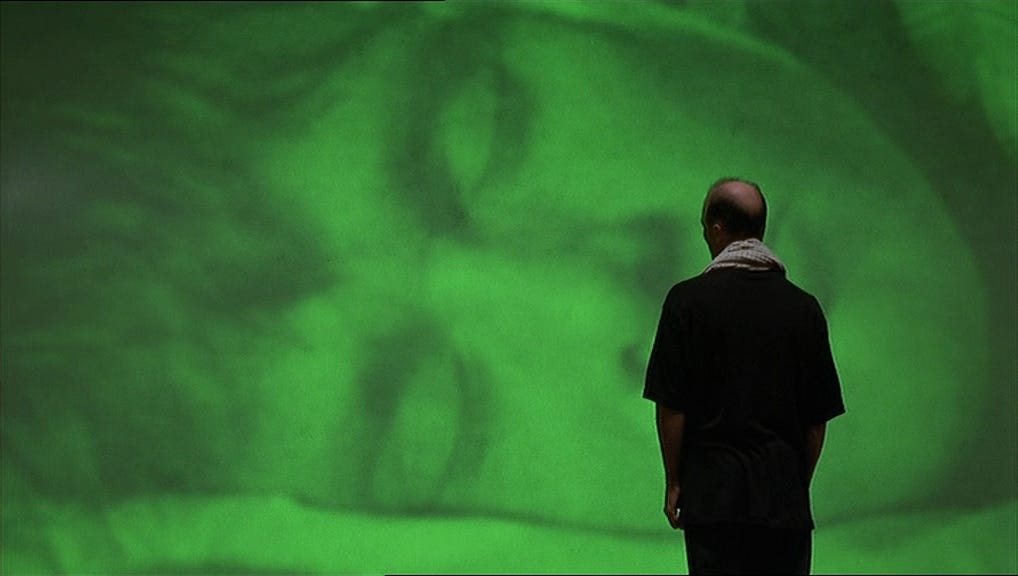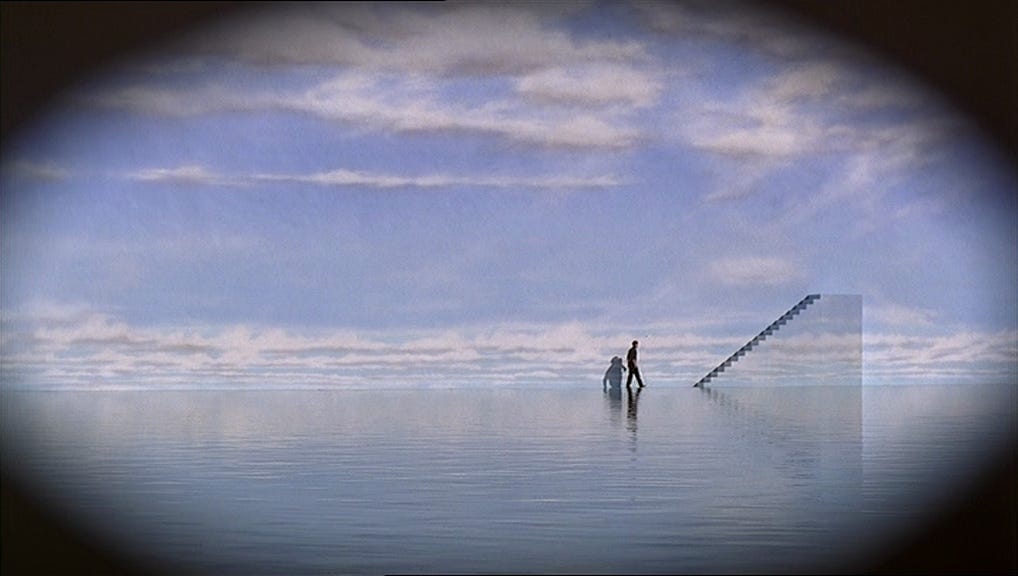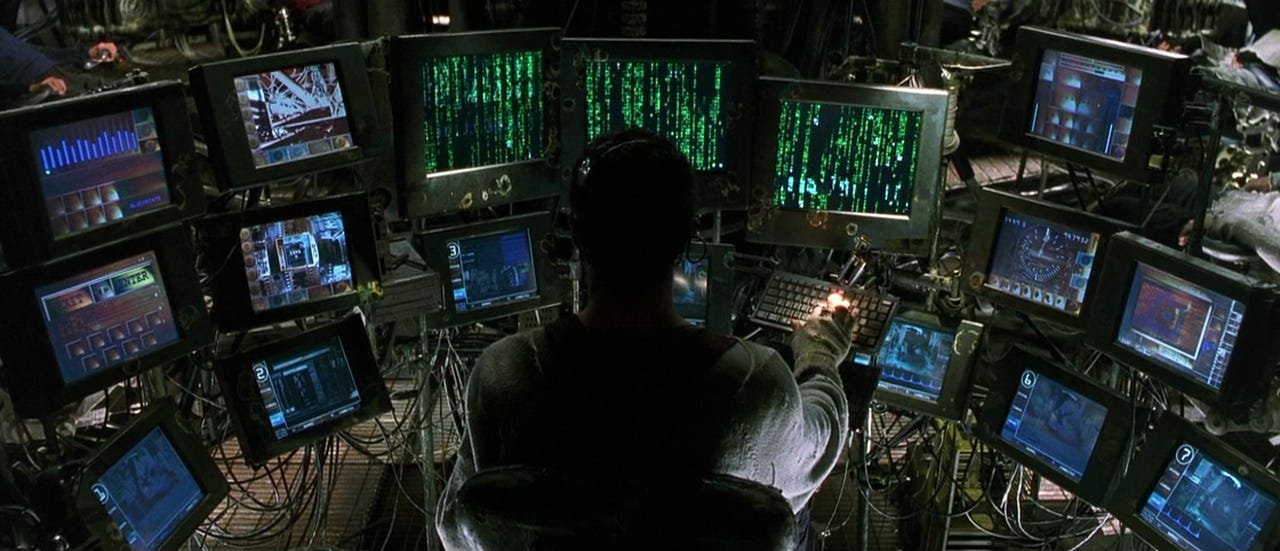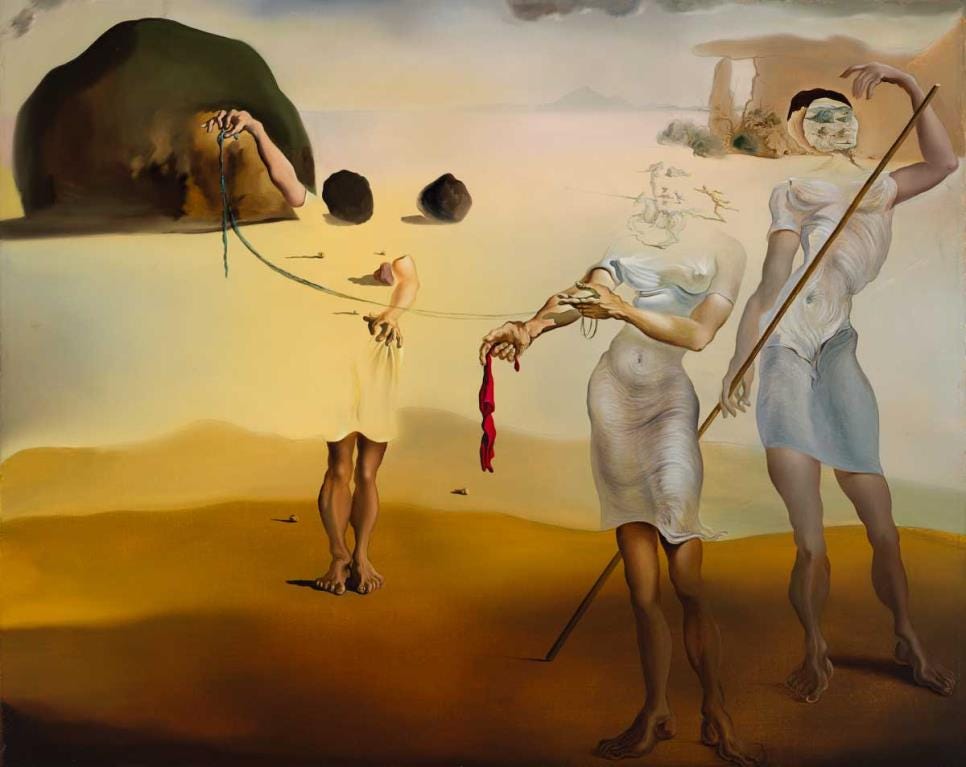Everything possible to be believed is an image of truth
Transcending dualism and non-dualism
Everything possible to be believed is an image of truth. -William Blake
There’s a test going around on the internet that claims to let you know where you draw the line on a spectrum of blue to green compared to other people. Some people see much bluer green, and some see more green blues. The dividing line, it turns out, is much more arbitrary than it would seem.
I remember wondering as a kid whether the color I see and call blue is the same as what someone else sees and calls blue. This test plays with that idea, but might there be an even more fundamental difference? What if my brain interprets color totally differently from yours? What if the only thing really preserved is the relationship between the colors and their relative relationships to each other? There really wouldn’t be any way to know for sure, because as long as the color I see that is associated with the sky is blue and so is yours, we can all communicate clearly about the set of colors we all call blue. But in the interior space where our inner selves dwell, your actual blue might look like my purple or red instead.
So, how do we know what’s truly real? Do we follow the white rabbit like Neo in the Matrix? What if it turns out the rabbit isn’t real either?
Historically speaking, humans have responded to this question in two ways —Dualism and Non-Dualism.
It Takes Two: Dualism
If you’ve ever felt that there is someplace out there where there is a deity or power in a higher realm watching over or interacting with us down here, congratulations, you’ve won dualism! Dualism is the viewpoint that our reality consists of two distinct parts that are separated from each other. Generally, these two parts are considered to be some form of spiritual existence and some form of material existence. Examples are Christianity and Gnosticism, where you have a higher spiritual realm where God or the Archons are, and then our corrupted material realm. The two realms and ideas are separated. Dualism will often set up oppositional forces like good and bad, spiritual or material, light and dark. Dualistic thought often considers the spirit to be imprisoned in the body and seeks its release as the only way to ascend back to the higher spiritual realm.
Plato writing in his work Phaedro says:
The lovers of knowledge are conscious that their souls, when philosophy receives them, are simply fastened and glued to their bodies: the soul is only able to view existence through the bars of a prison, and not in her own nature; she is wallowing in the mire of all ignorance
Philip K. Dick’s Black Iron Prison is another incarnation of the same idea.
In Gnostic dualism, nothing we experience in our material bodies or by way of our senses can be real because the reality we are immersed in is a flawed, corrupted construct that obscures and separates us from the reality that is the pure spiritual realm where the divinity exists.
There are many flavors of dualism, including more modern interpretations like Cartesian dualism. However, they all operate on the idea that our senses cannot be trusted, because either the source of information is incorrect, or our interpretation of the information is flawed and cannot be relied upon.
Chase the White Rabbit: Non-Dualism
Non-dualism takes the opposite tack and puts forward the idea that it is the perception of separation that is the illusion. Everything is just one big super-thing, and it just seems like we are separate because of our flawed perception of division. Many Eastern religions operate in this sphere of thought.
From the Buddhist Heart Sutra1:
Here then,
Form is no other than emptiness,
Emptiness no other than form.
Form is only emptiness,
Emptiness only forms.Feeling, thought, and choice,
Consciousness itself,
Are the same as this.
Much like dualism, though, non-dualistic thought considers the input of the senses to also be flawed but for different reasons. Sensory perceptions are the reason why we perceive ourselves as separate in the first place. Instead of relying on our senses, we must come to realize that we are part of everything around us.
In other words That Thou Art, as the priest says in the Gnostic Mass:
O secret of secrets that art hidden in the being of all that lives, not Thee do we adore, for that which adoreth is also Thou. Thou art That, and That am I.
Part of the journey of a non-dualistic worldview is to find ways to thwart Maya and awaken to the truth that transcends dualistic thinking. There is no spoon.
The I in the Triangle: Dual-Aspect Monism
It’s easy for magicians to see both dualistic and non-dualistic points of view. Both worldviews can serve us at different times, but neither seems to serve in all cases. I still need to go grocery shopping and pay my bills, which unfortunately seem to act as separate concepts from myself. My employer doesn’t accept Maya as a reason for being late to work.
As magically operant people, we have (probably) accepted that there is a lot of illusion of separation going on down here in Malkuth2, but objects and things functionally act as if they are distinct from our person. We perceive them with our senses, but our senses are simply signals processed by our brains, filtered by who knows what meat algorithms to create what we perceive as reality. Our world seems to operate as if dualism and non-dualism are real.
Enter a third way: dual-aspect monism.
Dual-aspect monism originated in the 17th century with Dutch philosopher Baruch Spinoza, who proposed that mind and body are aspects of a third underlying thing he called Deus sive Natura, “God or Nature.” Philosophers Immanuel Kant and Arthur Schopenhauer elaborated on this idea. However, it wasn’t until the advent of the quantum age of physics that dual-aspect monism found a scientific rationale to help give context to this third other realm.
In what must be the coolest team-up in history, psychologist Carl Gustav Jung and quantum physicist Wolfgang Pauli came up with the Jung-Pauli Conjecture to explain the problem of mind/matter duality in a way that incorporates a psychophysically neutral reality underlying both mental and physical phenomena. This third underlying realm is the fundamental realm from which both physical and mental phenomena arise. It essentially unifies the mind/matter problem by describing a framework where they both arise that incorporates both ideas. Events or phenomena in this realm have not yet differentiated into aspects of mind or matter. In other words, phenomena existing in this state have the potential to become either physical or mental. It is only in the decomposition, or differentiation, from this realm that objects become one or the other.
The action of decomposition is one of going from unity to multiplicity. However, this is not a destructive transformation. Just like a prism breaking down white light into its constituent parts, decomposition simply reveals parts that were already inherent in the whole. The parts become explicate upon their decomposition, but they were already enfolded in the whole to begin with.
Not only do these undifferentiated phenomena have the potential to become anything, they also exist outside of space or time because those ideas are inherently tied to the physical realm, which has not yet been differentiated. In essence, they are pre-temporal and pre-spatial.
One can make comparisons between the psychophysically neutral realm and the zero-point field.3
The psychophysically neutral realm is populated by the idea of archetypes. Here archetypes are not static, but dynamic organizing principles. They are holistic gestalts of meaning, such as the idea of the Hero or the Magician. This serves to explain why synchronicity can occur because once an archetype is activated it can decompose into both material and mental occurrences. The reason archetypes are not static monoliths is because of another function of the conjecture: backreaction.
Backreaction refers to the ability of phenomena, once differentiated and manifested, to have a reciprocal influence on the psychophysically neutral realm and perhaps even reshape the original archetype itself. Because the archetype lies beyond temporal considerations, the effect can be non-linear.
An example: A person begins to explore their artistic ability, activating the archetype of the Creator. This activation of the archetype in the psychophysically neutral realm gives rise to physical phenomena such as finding the right books for learning to sculpt and meeting an artist who becomes a mentor. It also brings about mental changes, such as seeing the world in a different way and noticing details about the environment, such as light and shadow. Perhaps these things result in synchronicities, like receiving a magazine about sculpture by mistake or noticing a flyer for beginner sculpture classes at your local community center. Because it’s a two-way street, a backreaction happens, transforming the archetype of the Creator. Perhaps the archetype persists, and this person becomes a famous artist, perhaps it fades away, and the person simply explores a new hobby for a while before moving on to something else.
Another example, as I was reading some text about doomsday prophets, my husband started randomly singing the gospel song “Washed in the Blood of the Lamb.” To me personally, the idea and the song are connected, what makes them meaningful is their temporal coincidence. I think many reading this will find themselves to have been micro-engaged in this way, leading to brief but meaningful synchronicities that have no real connection to anything other than themselves. Simultaneous manifestation of physical and mental phenomena like reading a word just as it was said aloud seems to be common amongst the magically inclined4.
Central to quantum physics and the Pauli-Jung conjecture is the idea that the observer is key to determining the outcome of any observable phenomena. The observer takes an active role and is the initiator of the backreaction effect. In a way, the observer is a co-creator and mediator between the psychophysically neutral realm and the mental and material events that transpire. Even the seemingly random synchronicities mentioned require the observer to be the mediator between both occurrences to give them meaning.
If you are magically minded, this whole conjecture might be getting your gears turning concerning how magic might work in this context. The average person might not be aware of archetypes in any context, nor of their role as observer and mediator between what transpires and the backreaction that feeds back into the archetype itself. What about the magician who can knowingly feed the chosen archetype they wish to work with with deliberate backreactions? Might this be the mechanism through which ritual, sigil, and all other sorts of magical actions work? Do egregores, spirits, and thought forms live in the psychophysically neutral realm? There are a lot of possibilities to explore using this framework.
Hello reader, thank you for ending up on my newsletter. I truly appreciate you! Since you made it this far and must have some passing interest in all things odd, I want to introduce you to a new podcast called Dispatches from Post-Reality. I am creating the art for the show episode covers and social media posts. It touches on some of the same esoteric subject matter you’ve come to love from this newsletter but with a decidedly funnier and much more casual tone. Check it out!
Malkuth is the 10th sphere on the Tree of Life that corresponds to Earth and matter.
Read more about the zero-point field in my previous post here.
Or common amongst everyone, we just take it more seriously.







